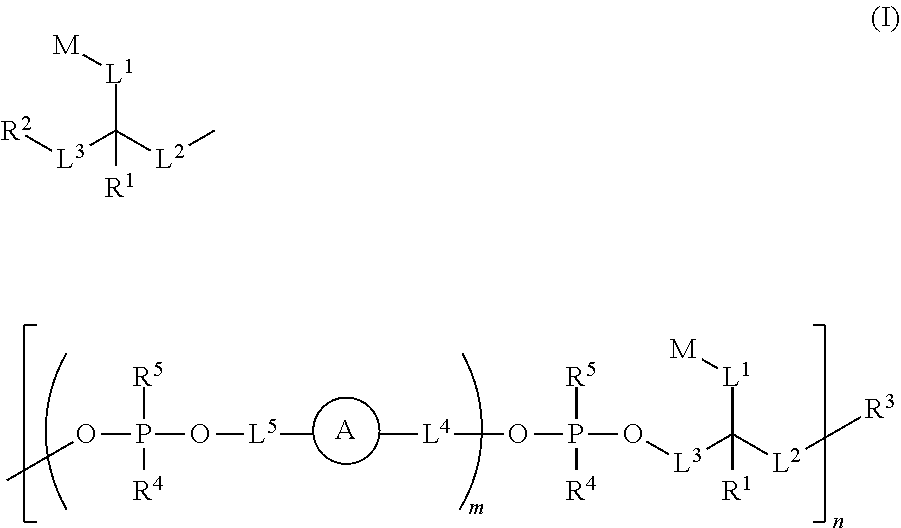Ultra bright dimeric or polymeric dyes with rigid spacing groups
a dimeric or polymeric dye and spacing group technology, applied in the direction of fluorescence/phosphorescence, group 5/15 element organic compounds, instruments, etc., can solve the problem that dimeric and polymeric dyes have not achieved the desired brightness increas
- Summary
- Abstract
- Description
- Claims
- Application Information
AI Technical Summary
Benefits of technology
Problems solved by technology
Method used
Image
Examples
example 1
Synthesis of Phosphoramidite Dye Monomers
[0274]
[0275]In a 250 mL round bottomed flask with stirring bar was placed pyromellitic anhydride (1.0 g, 4.59 mmol) and dioxane (50 mL). To this was added ethanolamine (622 μL, 11.5 mmol) and diisopropylethylamine (4.0 mL, 23 mmol). The flask was equipped with a reflux condenser, placed in an oil bath and heated to reflux overnight. The mixture was allowed to cool. The solids were filtered and retained for later. The filtrate was condensed and partitioned between ethyl acetate and water. The ethyl acetate layer was retained and the aqueous layer was extracted two additional times with ethyl acetate. The organic layers were combined, dried over sodium sulfate, filtered and concentrated to a solid. The solids from extraction and the earlier filtration were found to be identical by TLC and combined to afford the final material. (870 mg)
[0276]LC / MS of product showed m / z 305 associated with the largest peak. Overall purity was ˜79%.
[0277]
[0278]In ...
example 2
Synthesis of Oligomer Dyes
[0306]Oligomer dyes were synthesized on an Applied Biosystems 394 DNA / RNA synthesizer or on GE AKTÅ 10 OligoPilot on either 1 μmol or 10 μmol scales and possessed a 3′-phosphate group. Dyes were synthesized directly on CPG beads or on polystyrene solid support. The dyes were synthesized in the 3′ to 5′ direction by standard solid phase DNA methods. Coupling methods employed standard β-cyanoethyl phosphoramidite chemistry conditions. Different number of repeating units were incorporated by repeating the synthesis cycle the desired number of times with an appropriate phosphoramidite. All phosphoramidite monomers were dissolved in acetonitrile / dichloromethane (0.1 M solutions), and were added in successive order using the following synthesis cycles: 1) removal of the 5′-dimethoxytrityl protecting group with dichloroacetic acid in toluene, 2) coupling of the next phosphoramidite with activator reagent in acetonitrile, 3) oxidation with iodine / pyridine / water, an...
example 3
Characterization of Oligomer Dyes
[0309]1 mL of deionized water was added to the dried dye sequence prepared according to Example 2 to re-constitute and establish a concentrated stock of ˜0.3 to 1.0 mM (determined later). 24, aliquots of each dye construct were analyzed by HPLC-MS to determine identity and relative purity using 45° C. heated ultra-high performance 2.1 mm×50 mm C18 column (1.7 μm) with 150 mM HFIP / TEA (pH9) mobile phase, and methanol as organic elution component. Gradient was from 1-100% over 10 minutes. Electrospray ionization was used (in negative mode) to determine the molecular weights of the dye sequences and help to characterize impurities.
[0310]A sample was taken from a concentrated stock using a micropipettor and diluted appropriately in 0.1×PBS (10× to 100×) to be within linear range of the NanoDrop UV-vis spetrophotomer (Thermo Scientific). A blank measurement was performed on the NanoDrop using 0.1×PBS, and then the absorbance of the diluted dye sequence at...
PUM
| Property | Measurement | Unit |
|---|---|---|
| volume | aaaaa | aaaaa |
| pH | aaaaa | aaaaa |
| pH | aaaaa | aaaaa |
Abstract
Description
Claims
Application Information
 Login to View More
Login to View More - R&D
- Intellectual Property
- Life Sciences
- Materials
- Tech Scout
- Unparalleled Data Quality
- Higher Quality Content
- 60% Fewer Hallucinations
Browse by: Latest US Patents, China's latest patents, Technical Efficacy Thesaurus, Application Domain, Technology Topic, Popular Technical Reports.
© 2025 PatSnap. All rights reserved.Legal|Privacy policy|Modern Slavery Act Transparency Statement|Sitemap|About US| Contact US: help@patsnap.com



